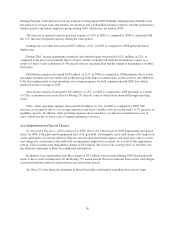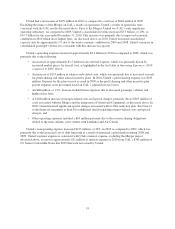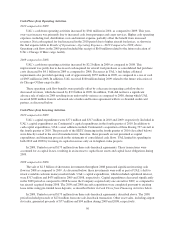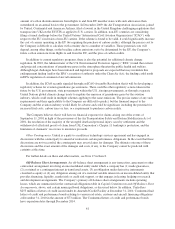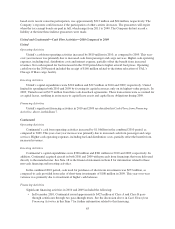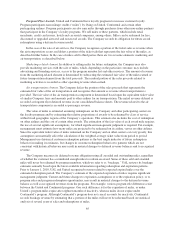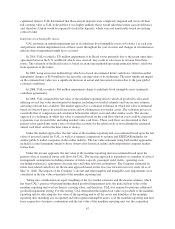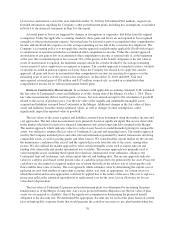United Airlines 2010 Annual Report Download - page 62
Download and view the complete annual report
Please find page 62 of the 2010 United Airlines annual report below. You can navigate through the pages in the report by either clicking on the pages listed below, or by using the keyword search tool below to find specific information within the annual report.(b) Includes interest portion of capital lease obligations of $116 million in 2011, $98 million in 2012, $92
million in 2013, $81 million in 2014, $64 million in 2015 and $288 million thereafter. Future interest
payments on variable rate debt are estimated using estimated future variable rates based on a yield curve.
(c) Represents our estimates of future minimum noncancelable commitments under our capacity purchase
agreements and does not include the portion of the underlying obligations for aircraft and facility rent that is
disclosed as part of aircraft and nonaircraft operating leases. Amounts also exclude a portion of United’s
capital lease obligation recorded for certain of its capacity agreements. See Note 15 to the financial
statements in Item 8 for the significant assumptions used to estimate the payments.
(d) Amounts represent postretirement benefit payments, net of subsidy receipts, through 2020. Benefit
payments approximate plan contributions as plans are substantially unfunded.
(e) Represents estimate of the minimum funding requirements as determined by government regulations.
Amounts are subject to change based on numerous assumptions, including the performance of assets in the
plan and bond rates. See Critical Accounting Policies, below, for a discussion of our assumptions regarding
UAL’s pension plans.
(f) Represents contractual commitments for firm order aircraft and spare engines only, net of previously paid
purchase deposits, and noncancelable commitments to purchase goods and services, primarily information
technology support. See Note 17 to the financial statements in Item 8 for a discussion of our purchase
commitments.
Contingencies.
Contingent Senior Unsecured Notes. UAL would be obligated under an indenture to issue to the PBGC up to
$500 million aggregate principal amount of 8% Notes if certain financial triggering events occur. The 8% Notes
would be issued to the PBGC in up to eight equal tranches of $62.5 million (with each tranche issued no later
than 45 days following the end of any applicable year). A triggering event occurs when UAL’s EBITDAR (as
defined in the PBGC indenture) exceeds $3.5 billion over the prior twelve months ending June 30 or
December 31 of any applicable fiscal year. The twelve-month measurement periods will end with the fiscal year
ending December 31, 2017. In certain circumstances, UAL common stock may be issued in lieu of the issuance
of the 8% Notes. A financial triggering event has not yet occurred under this indenture.
Legal and Environmental. The Company has certain contingencies resulting from litigation and claims
incident to the ordinary course of business. Management believes, after considering a number of factors,
including (but not limited to) the information currently available, the views of legal counsel, the nature of
contingencies to which the Company is subject and prior experience, that the ultimate disposition of the litigation
and claims will not materially affect the Company’s consolidated financial position or results of operations. The
Company records liabilities for legal and environmental claims when a loss is probable and reasonably estimable.
The amounts of these liabilities could increase or decrease in the near term, based on revisions to estimates
relating to the various claims.
Many aspects of the Company’s operations are subject to increasingly stringent federal, state and local laws
protecting the environment. Future environmental regulatory developments, such as climate change regulations
in the U.S. and abroad, could adversely affect operations and increase operating costs in the airline industry.
There are certain laws and regulations relating to climate change that apply to the Company, including the EU
Emissions Trading Scheme (“ETS”) (which is subject to legal challenge), environmental taxes for certain
international flights (including the United Kingdom’s Air Passenger Duty and Germany’s departure ticket tax),
limited greenhouse gas reporting requirements, and the State of California’s cap and trade regulations (which
impacts United’s San Francisco Maintenance Center and co-located cogeneration plant). In addition, there are
land-based planning laws that could apply to airport expansion projects, requiring a review of greenhouse gas
emissions, and could affect airlines in certain circumstances.
In 2009, the EU issued a directive to member states to include aviation in its greenhouse gas ETS, which
required the Company to begin monitoring emissions of carbon dioxide effective January 1, 2010. Beginning in
2012, the ETS would require the Company to ensure it has obtained sufficient emission allowances equal to the
60


